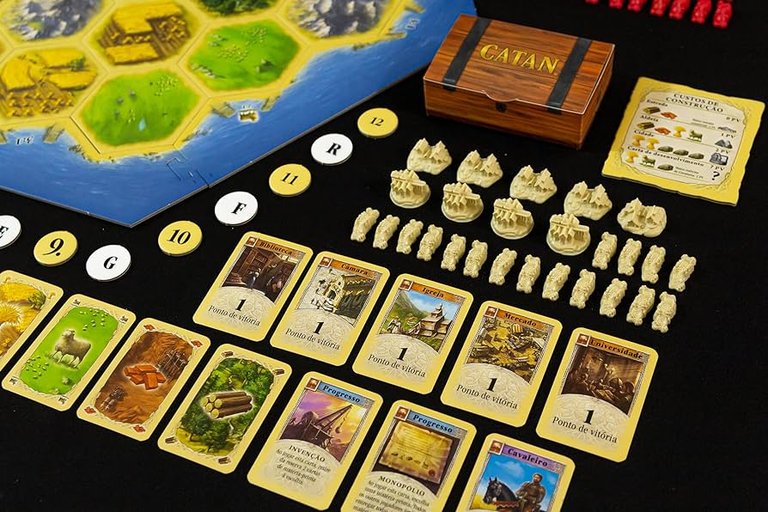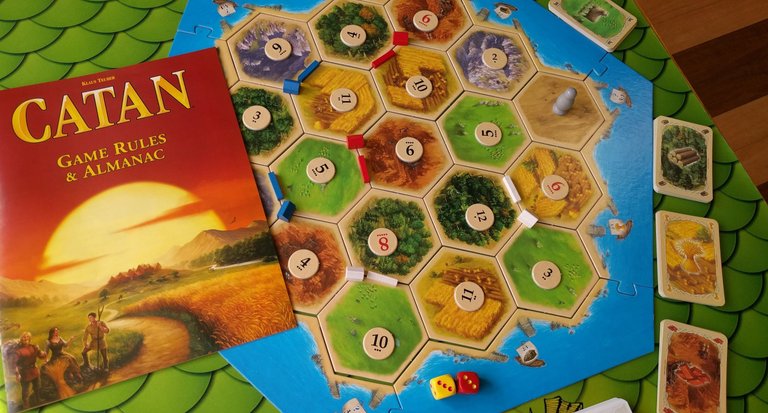Introduction to Catan: A Modern Classic
Since its release in 1995, the Catan board game has become a staple in the world of modern board gaming. Created by Klaus Teuber, this game has captivated players with its blend of strategy, negotiation, and luck. The game is set on the island of Catan, where players assume the roles of settlers attempting to build and develop holdings while trading and acquiring resources. The goal is to be the first to reach 10 victory points through a combination of building settlements, cities, and roads, and by acquiring development cards.

Game Components and Setup
Game Board and Tiles
The Catan board game features a modular hexagonal board, allowing for a different setup each time you play. This board consists of 19 terrain hexes representing different resources: brick, lumber, wool, grain, and ore. There are also desert hexes that do not produce resources. Surrounding the hexes are coastal frames and ocean tiles.
Resources and Cards
Each resource hex corresponds to a specific type of resource card. These resources are vital for building roads, settlements, and cities, and for purchasing development cards. The five resources in the game are:
- Brick
- Lumber
- Wool
- Grain
- Ore
Additionally, there are development cards that players can purchase. These cards can provide knights, progress cards, and victory points.
Number Tokens
Each resource hex, except for the desert, is assigned a number token ranging from 2 to 12. During the game, players roll two six-sided dice to determine which hexes produce resources for that turn.

Building Components
Players use roads, settlements, and cities to expand their influence on the island of Catan. Each player has a supply of pieces in their color:
- Roads: Used to connect settlements.
- Settlements: Basic building units that generate resources and contribute one victory point.
- Cities: Upgraded settlements that produce more resources and contribute two victory points.
How to Play Catan: A Step-by-Step Guide
Initial Placement
The game begins with each player placing two settlements and two roads on the board. The initial placement is crucial as it determines the resources you will collect early in the game. Each settlement must be placed on the intersection of three hexes, and each road must extend from a settlement.
Resource Production
At the start of each turn, the player rolls two dice. The sum of the dice roll corresponds to the number tokens on the board. Hexes with that number produce resources for players with settlements or cities adjacent to those hexes. For example, if a player rolls a 6, any hexes with a 6 will produce resources.
Trading and Building
After the dice are rolled, players can trade resources with each other or with the bank. Trading is a critical aspect of Catan, as it allows players to obtain the resources they need to build and develop. Players can then use their resources to:
- Build roads (cost: 1 brick and 1 lumber)
- Build settlements (cost: 1 brick, 1 lumber, 1 wool, and 1 grain)
- Upgrade settlements to cities (cost: 3 grain and 2 ore)
- Buy development cards (cost: 1 wool, 1 grain, and 1 ore)
Development Cards
Development cards offer various benefits. Knights can be used to move the robber and steal resources from other players, while progress cards provide unique advantages. Some development cards also grant additional victory points.
Robber and Resource Monopoly
When a 7 is rolled, the robber is activated. The player who rolled the 7 moves the robber to any hex, blocking resource production for that hex. They also get to steal one resource card from a player with a settlement or city adjacent to the robber's new location. This mechanic adds an element of strategy and player interaction.
Strategies for Winning Catan
Balanced Resource Collection
A key strategy in Catan is to ensure a balanced collection of resources. Early settlements should be placed on hexes that give access to a variety of resources, ensuring that no single type of resource is too scarce.
Expansion and Connectivity
Expanding your network of roads and settlements is essential. Aim to build settlements on new hexes with numbers that complement your existing resource production. Connecting your roads to reach key locations on the board can also block other players and give you strategic advantages.
Trade Effectively
Trade is a vital component of Catan. Be open to trading with other players but also be mindful of giving them resources that could help them more than it helps you. Utilize the 4:1 trade ratio with the bank or seek out 3:1 or 2:1 port trades if they are available.
Focus on Development Cards
Purchasing development cards can provide significant advantages, especially if you accumulate knights to achieve the Largest Army bonus, which grants two additional victory points. Progress cards and extra victory points from development cards can also be game-changers.
Adapt and Be Flexible
Flexibility is key in Catan. Adapt your strategy based on the resources you collect, the actions of other players, and the development of the board. Being able to shift your focus when necessary can provide the edge needed to win.
Variants and Expansions
Seafarers Expansion
The Seafarers expansion introduces sea travel and exploration, adding new strategic dimensions to the game. Players can build ships and discover new islands, enhancing the variability and replayability of the game.
Cities and Knights Expansion
The Cities and Knights expansion adds complexity by introducing city improvements and barbarian attacks. Players must balance building their cities with defending against invasions, adding new layers of strategy and interaction.
Other Expansions
Catan also offers other expansions and scenarios, such as Traders & Barbarians and Explorers & Pirates, each bringing unique elements and new challenges to the game.
Conclusion
The Catan board game remains a timeless and engaging game, combining strategic depth with social interaction. Whether you are a seasoned player or new to the world of Catan, the game's dynamic nature ensures that no two games are ever the same. By understanding the core mechanics, developing effective strategies, and adapting to the ever-changing board, you can enhance your gameplay and enjoy countless hours of fun and competition on the island of Catan.